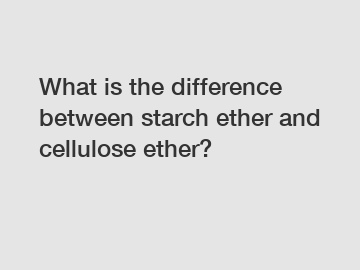Starch ether and cellulose ether are two widely used compounds in various industries, particularly in the construction and pharmaceutical sectors. While both are ethers, they have distinct differences in terms of their properties, applications, and effects. Understanding these differences is crucial for selecting the most suitable compound for a specific application.
Starch ether is derived from starch, which is a carbohydrate commonly found in plants. It is typically produced by reacting starch with an alkali and an etherifying agent. This chemical modification alters the properties of starch, making it more soluble in water and enhancing its thickening and binding capabilities. Starch ether is commonly used as a thickener, binder, stabilizer, and film-forming agent in various products such as adhesives, paints, food products, and pharmaceuticals.
On the other hand, cellulose ether is derived from cellulose, which is the main component of plant cell walls. It is produced by reacting cellulose with an alkali and an etherifying agent. Like starch ether, cellulose ether exhibits improved solubility in water and enhanced thickening properties compared to native cellulose. Cellulose ether is widely used as a thickener, stabilizer, film-forming agent, and rheology modifier in products such as paints, cosmetics, pharmaceuticals, and construction materials.

One of the key differences between starch ether and cellulose ether lies in their chemical structures. Starch ether is composed of glucose units linked together in long chains, whereas cellulose ether is composed of glucose units linked together in long chains but with a different arrangement, which gives it unique properties. This structural difference accounts for the varying solubility, thickening capabilities, and overall performance of starch ether and cellulose ether in different applications.
Related links:Another significant difference between starch ether and cellulose ether is their compatibility with other compounds. Starch ether tends to have better compatibility with organic solvents and certain chemicals compared to cellulose ether, making it a preferred choice in certain applications. Cellulose ether, on the other hand, is more stable in aqueous solutions and is often used in products that require water-based formulations. Understanding the compatibility of these ethers with other ingredients is essential for achieving the desired performance and stability in the final product.
In terms of performance, starch ether and cellulose ether exhibit different rheological properties, which can impact the flow, viscosity, and overall behavior of a product. Starch ether typically provides higher viscosity and better thickening properties in low-shear conditions, making it suitable for applications that require enhanced stability and suspension of particles. Cellulose ether, on the other hand, offers superior viscosity control, shear-thinning behavior, and film-forming properties, making it ideal for applications that require precise control over flow and coating thickness.
The choice between starch ether and cellulose ether ultimately depends on the specific requirements of the application. While both compounds offer similar benefits such as improved solubility, thickening, and binding capabilities, their distinct properties and performance characteristics make them suitable for different applications. Considerations such as compatibility, rheological properties, and desired performance outcomes should guide the selection of the most appropriate ether for a particular product or process.
In conclusion, starch ether and cellulose ether are versatile compounds with unique properties and applications in various industries. Understanding the differences between these two ethers is essential for selecting the most suitable compound for a specific application. Whether you are formulating adhesives, paints, pharmaceuticals, or construction materials, choosing the right ether can make a significant difference in the performance, stability, and overall success of your product. Be sure to consult with experts in the field to determine the best ether for your needs and unlock the full potential of these powerful compounds.
The company is the world’s best Gypsum Retarder Suppliers, gypsum retarder manufacturer, hydroxypropyl starch ether supplier supplier. We are your one-stop shop for all needs. Our staff are highly-specialized and will help you find the product you need.
269
0
0
All Comments (0)
Previous: What is the introduction of ETC?
Next: Everything You Need to Know about Carboxymethyl Cellulose Powder
If you are interested in sending in a Guest Blogger Submission,welcome to write for us!
Comments